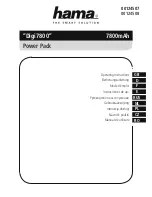
13
SALICRU
5.2.11.1. Electronic unit for NIMBUS remote
maintenance (optional).
The NIMBUS electronic remote management unit enables real
time monitoring, analysis and technical support 24 hours a day,
7 days a week, by members of our staff, thus reducing the mean
time to repair (MTTR) in the event of any unexpected situation.
During monitoring, an events and alarms history is created to
enable a thorough analysis of the device, providing valuable in-
formation on operating tendencies and thus identifying potential
future problems. In addition, a detailed device status report is
sent to the customer every month.
5.2.12. Protection.
The device’s own control includes a current limitation system that
ensures that all components work in the correct mode, thus guar-
anteeing the expected life of the system.
With the input circuit breaker protection, protection against trans-
former overload is guaranteed, preventing overheating and pre-
mature ageing leading to system failures. In addition, the use of an
input circuit breaker enables the user to reset the system, avoiding
technical service interventions for fuse changes that would involve
an unacceptable shutdown period for the application.
The semiconductor temperature control and overtemperature
shutdown system provides added protection by reducing the need
for device interventions in the event of abnormal operation, since
it protects the most important part of the system, preventing failure
and saving on possible expensive repairs.
For the protection of personnel, it also has isolation failure detec-
tion, which provides an alarm if a potentially dangerous situation
arises.
In addition to the protection of batteries by means of fuses in-
dicated above, there is an output fuse in the rectifier assembly
where it joins the accumulator bank and load output.
5.3. Management of batteries and
charging levels.
The charger is fully automatic, capable of operating autono-
mously.
It is designed in such a way that the different output voltage
levels according to the current/voltage characteristic are stabi-
lised at 1% of their rated value for an operating range of 0% to
100% of the rated load in the event of input wave voltage and
frequency variations.
The charger’s output voltage ripple factor does not exceed 1%
defined as the ratio between the peak-to-peak value and the
RMS value of the wave, with the battery connected to its output
or 3% without it for an operating range of 0 to 100% of the rated
load in the event of input wave voltage and frequency variations.
The output current of each charger is equal to the current de-
manded by 100% of the loads plus the maximum charging cur-
rent of the battery according to the current/voltage characteristic
corresponding to fast charging, so that the battery can recover
100% of the capacity transferred during the specified discharge
cycle in a maximum period of 12 hours, with the charger simulta-
neously powering 100% of the loads.
5.3.1. Charging levels.
The device is designed to work at three charging levels and
therefore at three voltage levels:
5.3.1.1. Float
The charger maintains its corresponding stabilised voltage by
means of which it powers the assigned loads and supplies the
current for preserving the battery charge according to the cur-
rent/voltage characteristic.
Under normal conditions, the charger will be in float mode, sup-
plying the battery with a maintenance current, the small current
that is provided to the battery to keep it charged and prevent self-
discharge.
When a mains failure occurs, the battery will discharge according
to the requested consumption.
5.3.1.2. Fast charging.
In this position, the charger provides the permanent load and
battery charging according to the current/voltage characteristic,
keeping its voltage stabilised. When mains power returns, the
rectifier will automatically switch to fast charging mode, supplying
the current requested plus a limited and constant current (equal
to the capacity, in Ah/5) for restoring the charge of the battery.
Once the maximum operating voltage level has been reached,
the battery will gradually absorb less current.
Once the battery recharges, the device will automatically go to
float mode.
The duration of the fast charge will be proportional to the dis-
charged Ah.
This kind of charging can be started automatically or manually
via the control panel.
5.3.1.3. Exceptional charging.
In this position, the charger will switch to exceptional manual
charging of the battery, which has the purpose of homogenising
and regenerating the active substances in the battery electrolyte.
Exceptional charging will only be carried out by manual forcing
via the control panel and with the device out of service if it is con-
sidered harmful for the loads connected to the rectifier output.
The timing of the charging process (24 h) must be set at the start,
so that it will end automatically. Once exceptional charging is fin-
ished, the charger will switch automatically to float mode.
In the event of manual interruption of exceptional charging, the
charger will automatically switch to fast charging mode until the
batteries are fully charged and then float charging.
Summary of Contents for DC POWER-L Series
Page 2: ...2 USER MANUAL...
Page 31: ...31 SALICRU...














































